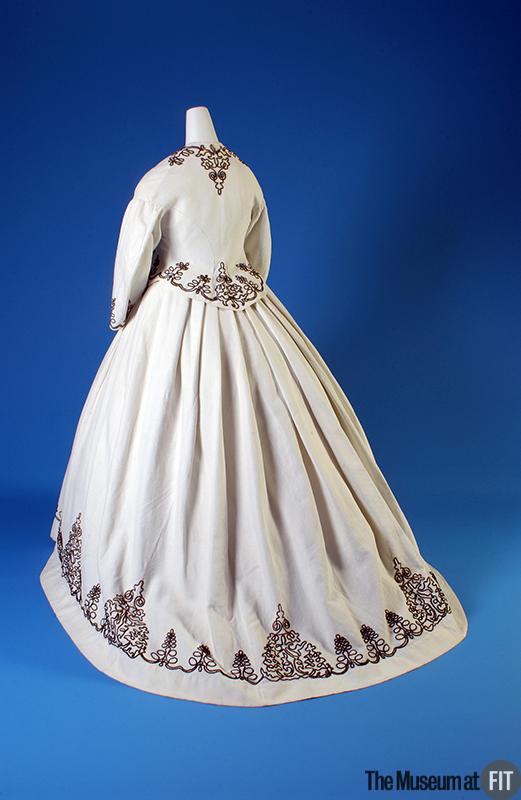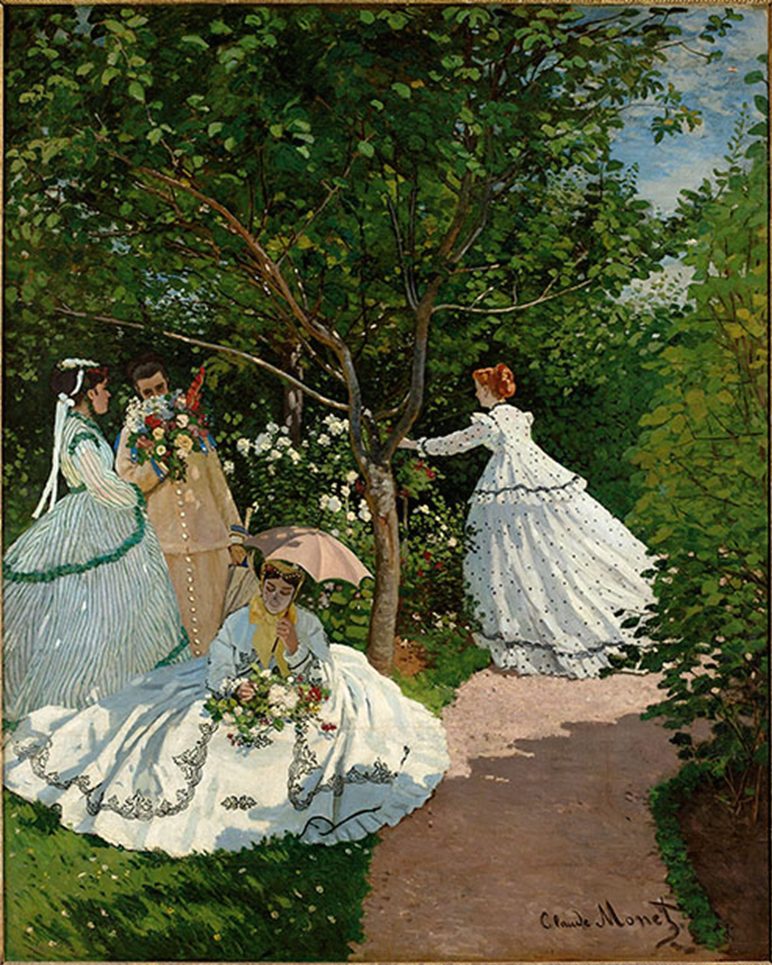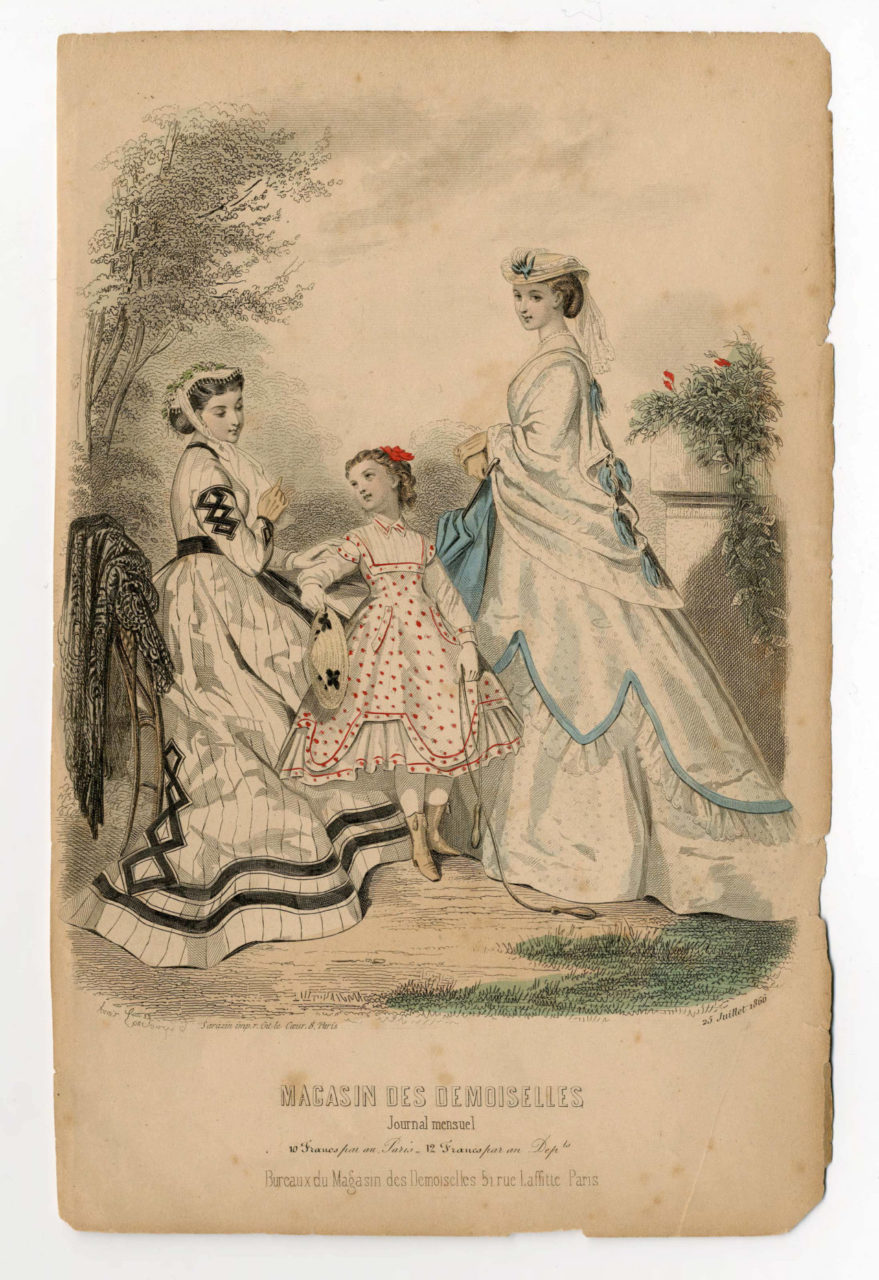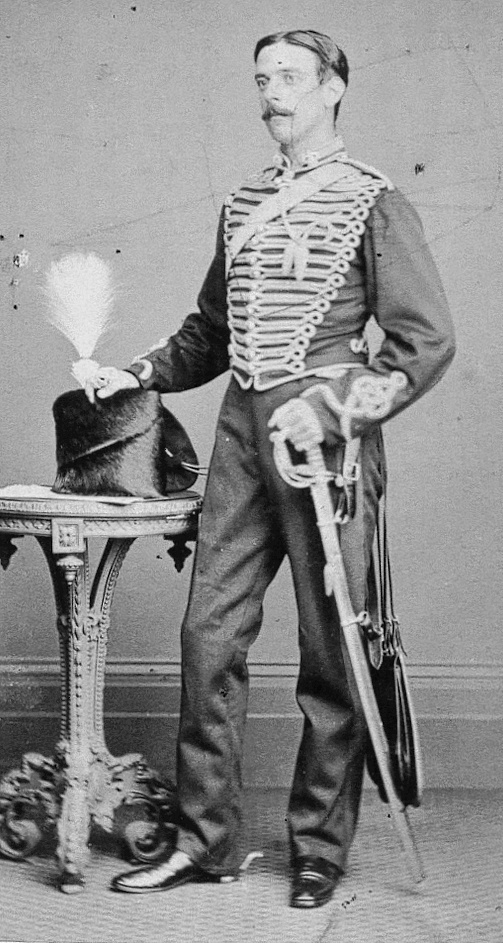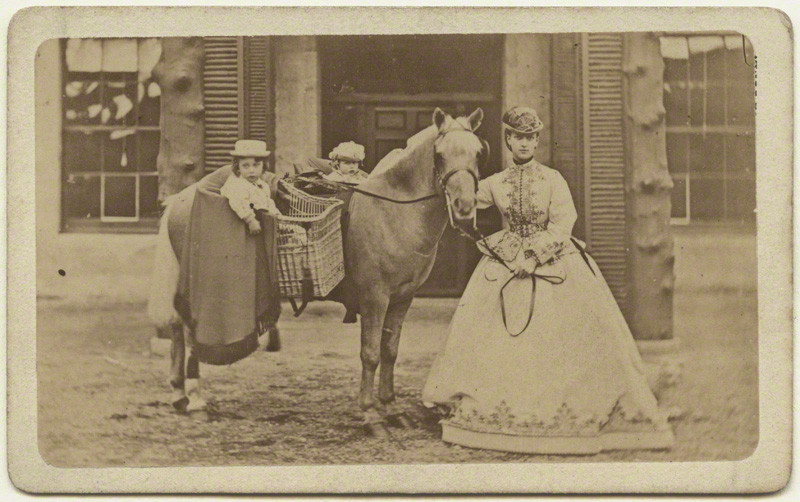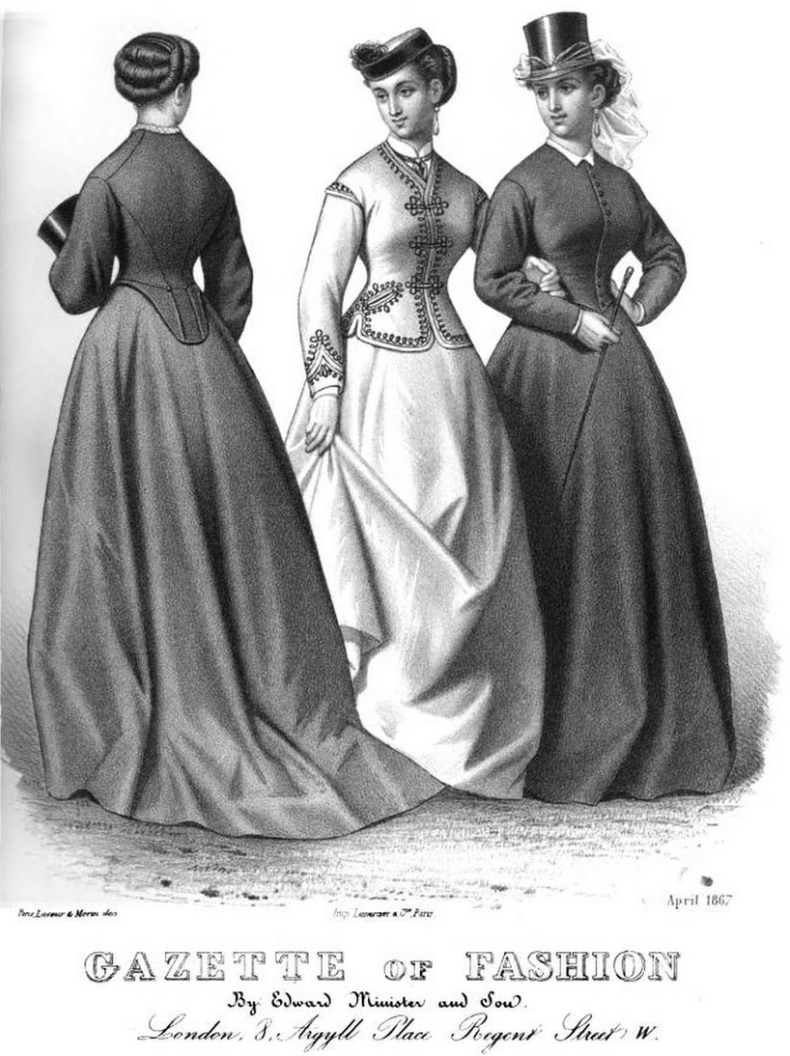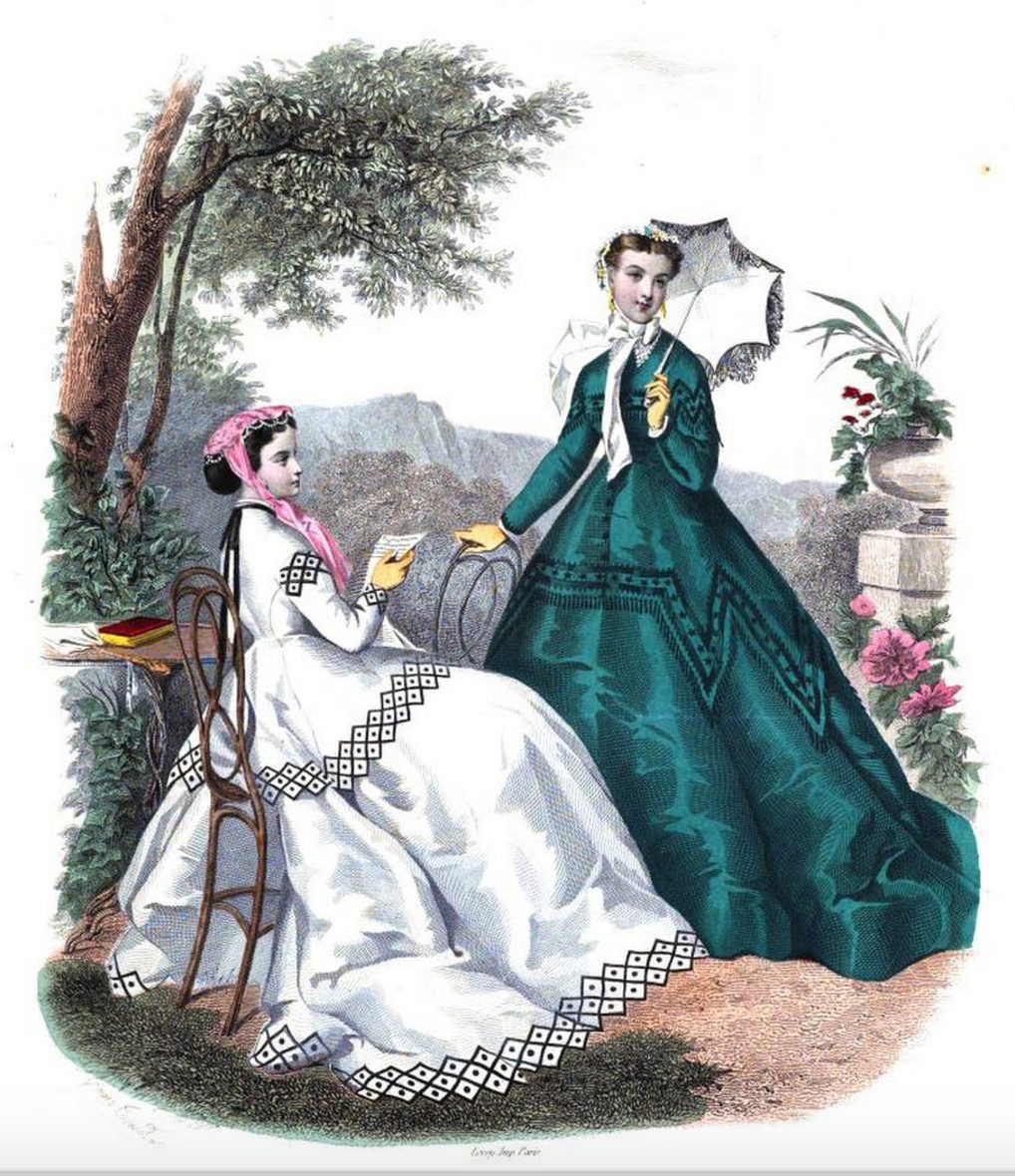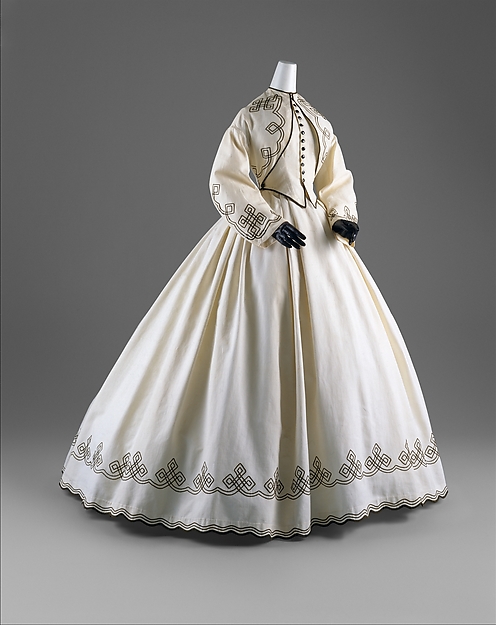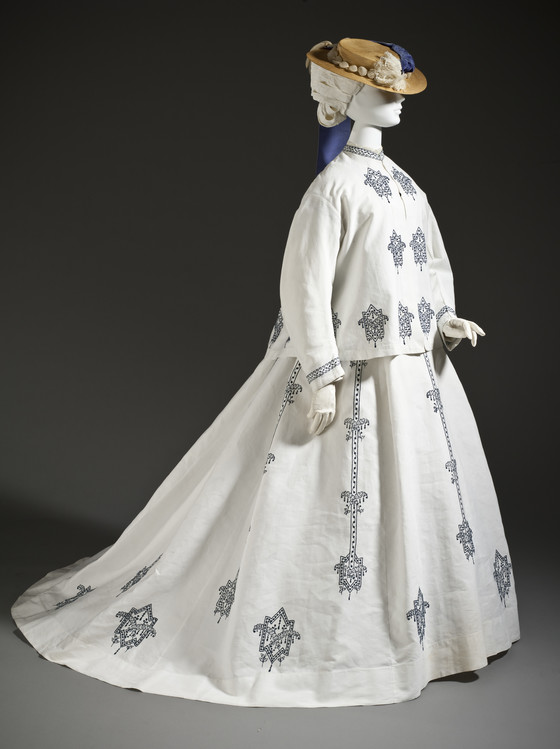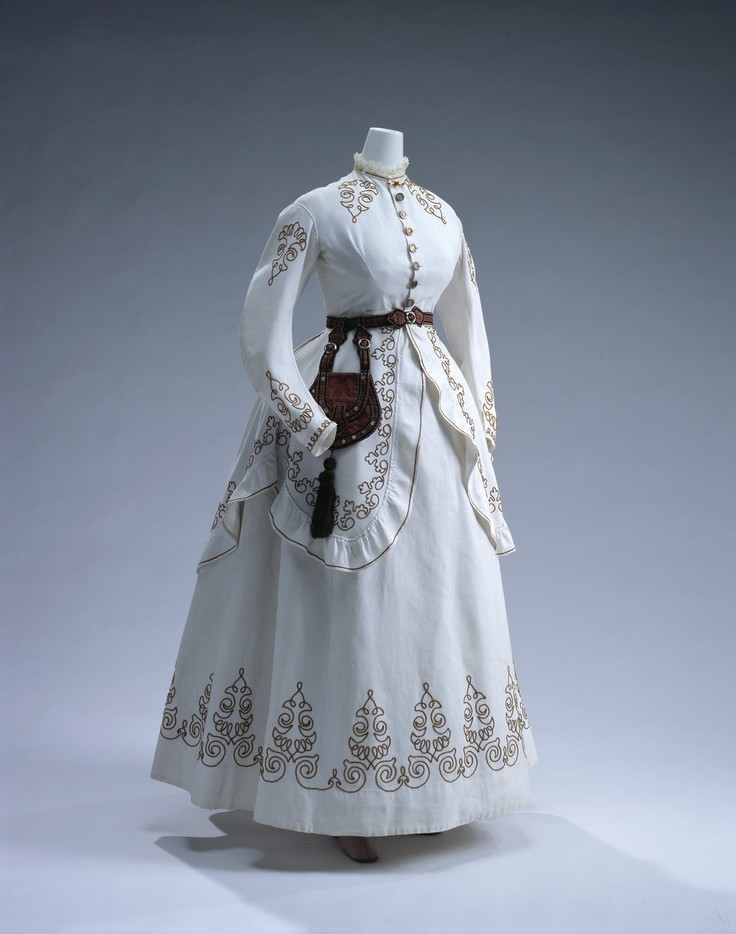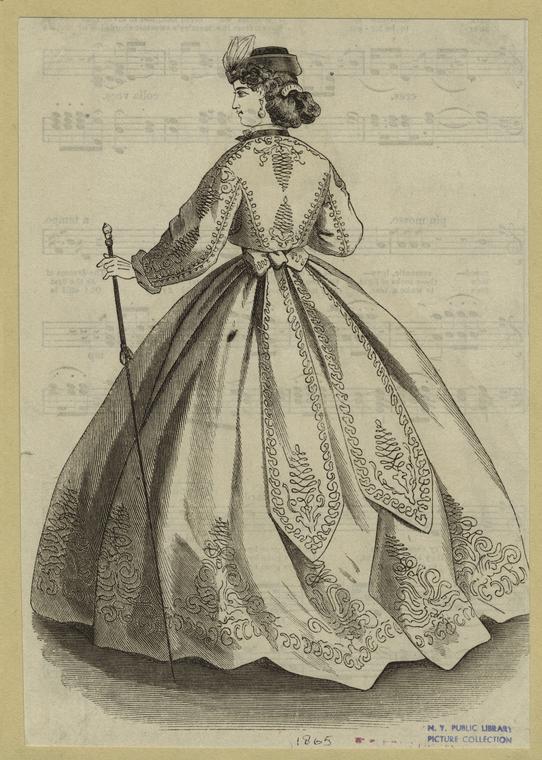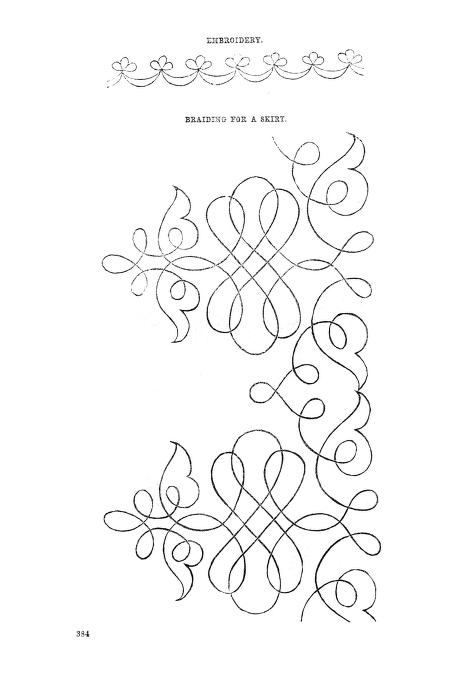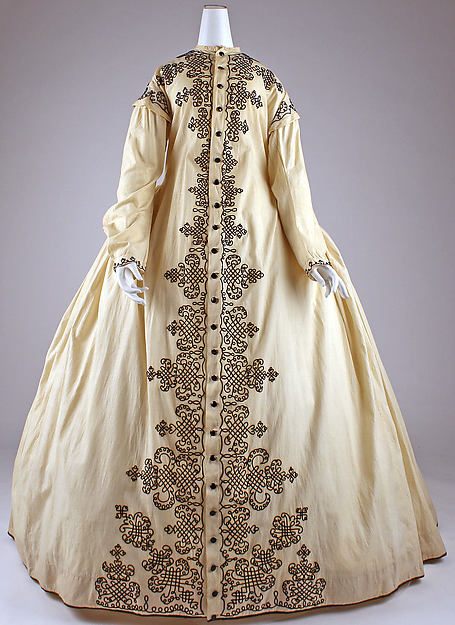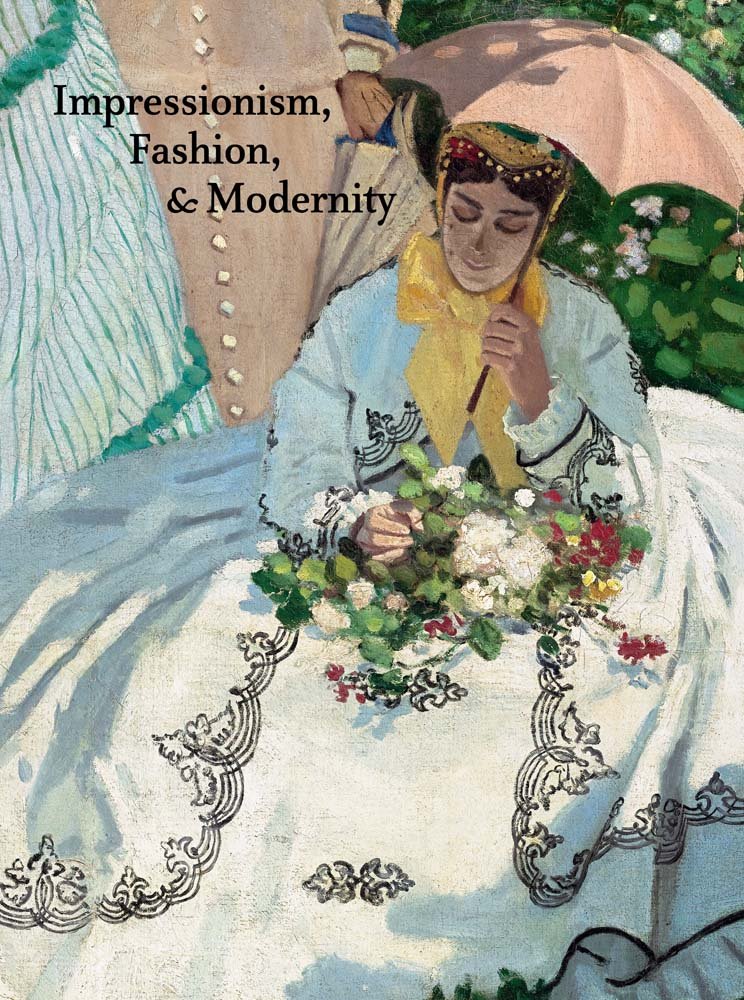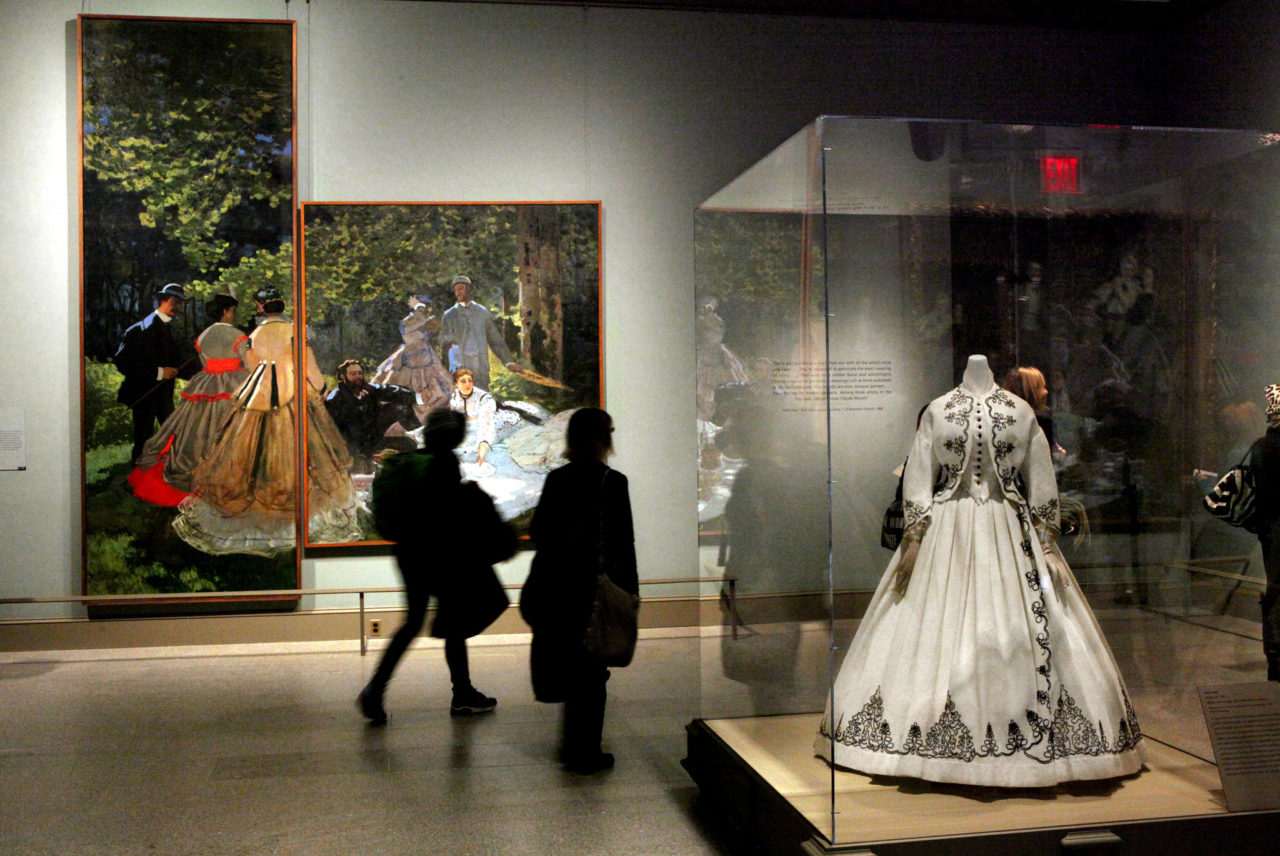About the Look
This 1867 afternoon dress features a full crinolined skirt in white cotton piqué with black cording running asymmetrically down the left side and forming a border at the skirt’s hem (Fig. 1). The otherwise plain vest-like bodice features 11 black buttons down the center front ending in a sharp point (Fig. 2). The zouave-style jacket, which fastens at the neck and is open at the waist, again features black cording along the jacket edges and at the cuffs. As is typical for the late 1860s, the skirt silhouette is shifting toward being flatter in the front with slightly more fullness in the back (Fig. 3) rather than being perfectly rounded throughout. White cotton piqué was often recommended for summer walking or seaside promenade dresses for its sturdy breathability.
Fig. 1 - Designer unknown. Rear view, Afternoon dress, 1867. White cotton piqué and black cotton cording. New York: Museum at FIT, P90.22.2. Source: Museum at FIT
Fig. 2 - Designer unknown. Detail, Afternoon dress, 1867. White cotton piqué and black cotton cording. New York: Museum at FIT, P90.22.2. Source: Pinterest
Fig. 3 - Installation view, “She’s Like a Rainbow: Colors in Fashion,” Museum at FIT (Nov. 2006 to May 2007). . Source: Museum at FIT
Fig. 4 - Claude Monet (French, 1840-1926). Women in the Garden, 1866. Oil on canvas; 255 x 205 cm. Musée d'Orsay: Paris, RF 2773. Source: Musée d'Orsay
Afternoon dress, 1867. White cotton piqué and black cotton cording. New York: Museum at FIT, P90.22.2. Source: Pinterest
About the context
Avery similar white dress with black cord decoration can be seen in French artist Claude Monet’s 1866 Women in the Garden (Fig. 4). Monet’s painting and the FIT dress were featured together in the 2013 exhibition “Impressionism, Fashion, & Modernity” at the Metropolitan Museum of Art, alongside other large scale Impressionist works depicting contemporary fashions (Fig. 18). The dress of the figure seated on the ground features extremely similar cording, though in this case arranged symmetrically, and her bonnet and parasol suggest the sorts of accessories that would be worn with such a look.
This look was very fashionable for the time, as military-inspired dress was quite popular in 1860s women’s wear, with black cording on white cotton particularly favored (Fig. 5). As the Museum at FIT notes:
“Black cording is worked into a stylized variation of the ‘Austrian knot’ on this white piqué afternoon dress. Commonly worn by military officers, the Austrian knot was an applied design of twisted cord or braid used to embellish their uniforms. Here, the interlaced cord work accentuates the skirt’s fullness, which is at the back of the dress, and the military motif has been incorporated into a scrolling geometric pattern, creating a contrasting border design characteristic of the period.”
For an example of the ‘Austrian knot’ motif on a mid 19th-century Hussar uniform sleeve see Figure 6.
The English Queen Alexandra wears a very similar dress in an 1866 carte-de-visite photograph (Fig. 7) while accompanying her children on horseback. Indeed the look in its military-inspired simplicity is often illustrated alongside riding dress, as you can see in an April 1867 plate (Fig. 8) from the Gazette of Fashion, a tailors’ journal. Fashion plates from the summer of 1866 (Figs. 5 & 9) feature similar white dresses accented in black in garden settings.
Fig. 5 - Adèle-Anaïs Toudouze (French, 1822-1899). Magasin des Demoiselles, (July 25, 1866). Hand-colored engraving. Source: The Met
Fig. 6 - Photographer unknown. Austrian Hussar uniform with "Austrian knot" pattern on the sleeve, undated. Photograph. Source: Victorian Strollers
Fig. 7 - W. & D. Downey (British, 1855-1940). Prince Albert Victor, Duke of Clarence and Avondale; King George V; Queen Alexandra, 1866. Albumen carte-de-visite; 5.4 x 9.3 cm (2 1/8 in x 3 5/8 in). London: National Portrait Gallery, x129624. Source: National Portrait Gallery
Fig. 8 - Artist unknown. Gazette of Fashion, vol. 21, no. 252 (April 1867). Source: Google Books
Fig. 9 - Adèle-Anaïs Toudouze (French, 1822–1899). La Mode illustrée, vol. 7, no. 25 (June 17, 1866). Hand-colored engraving. Source: Google Books
Fig. 10 - Designer unknown (American). Promenade dress, 1862-64. Cotton. New York: The Metropolitan Museum of Art, C.I.60.6.11a, b. Gift of Chauncey Stillman. Source: The Met
Fig. 11 - Designer unknown (French). Woman's Seaside Ensemble (Jacket, Bodice, and Skirt), 1864-1867. Cotton plain weave; with supplementary warps (ribbed), and cotton machine embroidery cm. Los Angeles: Los Angeles County Museum, M.2007.211.944a-c. Purchased with funds provided by Suzanne A. Saperstein and Michael and Ellen Michelson. Source: LACMA
Fig. 12 - Designer unknown (English). Day dress, 1867-1868. White cotton piqué set of bodice, skirt and overskirt; code embroidery of ocher brown cotton threads; metal buttons at front; brown silk taffeta chatelaine cm. Kyoto: Kyoto Costume Institute, AC10225 1999-40-4AC, AC3337 1980-21-23AB. Source: Kyoto Costume Institute
The look was suited for more active pursuits and surviving examples in other costume collections are often labeled “walking dresses” or “promenade dresses.” An English day dress in cotton piqué with matching chateleine (purse) convenient for the woman on the move while different in cut from FIT’s dress features very similar cording (Fig. 12). Of it the Kyoto Costume Institute writes:
“A three-piece dress that has the appearance of a jacket and skirt. The arabesque pattern on the white cotton piqué creates a rhythmical visual effect. The taste for orientalism at the time extended to fashion, with arabesque patterns that were depicted in the paintings of the time frequently appeared in fashion magazines. Also fashionable were walking and travelling wear in cotton piqué with its distinctive rippled texture.”
Similar white walking dresses with black cording are part of the collections of The Met, LACMA, Palais Galliera and the Manchester City Galleries (Figs. 10-13). Indeed, this type of dress and decorative technique was popular internationally and reproduced not just in French, but also American fashion magazines (Fig. 14). Godey’s Lady’s Book and other magazines published diagrams (Fig. 15) for similar braiding so that women could make or commission their own copies. Black cording on white cotton is also found on morning dresses of the 1860s, as two examples in the Met’s collection attest (Fig. 16).
Fig. 13 - Designer unknown (French). Walking ensemble: jacket and skirt, 1866-1867. Beige cotton, light greenish-black silk braid, light greenish-black silk plaiting. Paris: Palais Galliera, musée de la Mode de la Ville de Paris, GAL1920.1.2298. Gift of the Société de l'Histoire du Costume. Source: Palais Galliera
Fig. 14 - Artist unknown (American). Woman in dress, 1865. New York: Art and Picture Collection, The New York Public Library, 803282. Source: New York Public Library Digital Collections
Fig. 15 - Braiding for a Skirt. Godey's Lady's Book, vol. 69, no. 31 (November 1864). Source: Archive.org
Fig. 16 - Designer unknown. Morning dress, early 1860s. Cotton. New York: The Met, C.I.60.6.10. Gift of Chauncey Stillman, 1960. Source: The Metropolitan Museum of Art
Its Afterlife
FIT’s dress has featured prominently in two recent fashion exhibitions: FIT’s own “She’s Like a Rainbow: Colors in Fashion,” which ran from November 2006 to May 2007 (Fig. 3), and “Impressionism, Fashion, & Modernity,” which ran from February to May 2013 at the Metropolitan Museum of Art in New York (Fig. 18).
Fig. 17 - Exhibition catalogue with a detail of Monet's. Women in the Garden, 1866. Source: Amazon
Fig. 18 - Suzanne DeChillo. Installation view of FIT dress with Monet’s. Luncheon on the Grass, in Impressionism, Fashion, and Modernity, Metropolitan Museum of Art (Feb. to May 2013). Source: New York Times
References:
- “Afternoon dress.” Museum at FIT. Accessed January 23, 2017. http://fashionmuseum.fitnyc.edu/
- “Day dress.” Kyoto Costume Institute. Accessed January 23, 2017. http://www.kci.or.jp/archives/digital_archives/detail_234_e.html
-
Groom, Gloria Lynn, ed. Impressionism, Fashion & Modernity. Chicago: Art Institute of Chicago, 2012. http://www.worldcat.org/oclc/794814340


